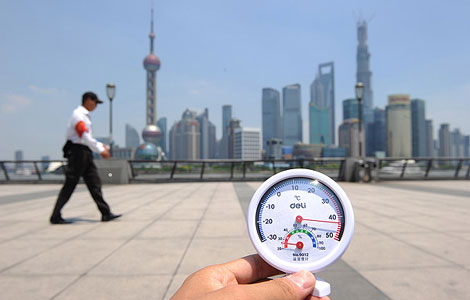Raining on cities' GDP parades
Updated: 2013-08-07 07:26
By Gao zhuyuan (China Daily)
|
||||||||
When I was a little kid, my friends and I enjoyed rainy days and the subsequent water fights immensely; we'd sing the Cantonese nursery rhyme Big Rain while wading through flooded streets on our way home from school. However, such scenes of heavy rain and street flooding are no longer just part of the Lingnan culture in Guangdong province and nearby regions such as Hong Kong and Macao.
Last year torrential rain and floods wreaked havoc in Beijing, claiming more than 70 lives and causing billions of yuan in economic losses.
This year, Wuhan in Central China was hit by rainstorm-triggered floods in July that led to the provincial capital being dubbed the Oriental Venice. Hard on the heels of that, half of Chengdu was inundated by storm water runoff.
Photos of waterlogged cities are now popular online, as Chinese netizens playfully invite visitors to admire the "sea views" in flooded inland cities.
Global climate change, of course, has to take the blame for such scenes. But there is also another culprit, namely the neglect in urban planning that has resulted in the underdevelopment of crucial infrastructure and the rapid loss of "natural sponges" such as wetlands.
Urban sprawls have rapidly encroached on the countryside in the past decade, as local policymakers have developed an obsession with building brand new urban districts or erecting landmark buildings. Compared with the infrastructure boom above the ground, sub-surface infrastructure development continues to be out of step with the urbanization process.
For example, despite concerns about eventually building a "ghost town", the Lanzhou government and businesses planned to invest 22 billion yuan ($3.6 billion) to build a new urban area on the outskirts of the northwestern provincial capital, until the provincial environmental watchdog suspended the project in April. To many, the Lanzhou initiative was indicative of local governments' notorious obsession with expensive urban development programs aimed at stimulating GDP growth and bolstering property development in order to boost their fiscal revenues.
While they are happy to splash the cash on what can be seen above ground, local governments have adopted a penny-pinching approach to the underground infrastructure that is necessary.
Unfortunately, the folly of this approach only comes to the fore when flood-induced economic losses and casualties make the headlines.
The Ministry of Housing and Urban-Rural Development recently urged cities to assess the risk of flooding and build sound drainage systems within a 10-year period, and a few cities have come around to the idea of investing in their drainage systems. Guangzhou plans to spend 25 billion yuan on a deep-tunnel drainage project, the first in the Chinese mainland, to prevent urban flooding and sewage overflow pollution.
Such a project will not lead to immediate gains, and there are doubts that the huge investment will pay off in the long run. Guangzhou's plan might also be too expensive an example for others to follow at a time when local government debts have become a prominent concern, but the accumulated debts accruing from the underdevelopment of urban drainage systems must be cleared sooner rather than later.
Something more than structural measures is also needed to improve our cities' flood preparedness. Even an engineering marvel such as Chicago's deep-tunnel project is now being called into question, as a record-breaking deluge in April has prompted the residents of Chicago to complain that apart from building an expensive labyrinth of sewers, the city should have spent more on restoring and maintaining natural green systems to fix the chronic problem.
The widespread use of impervious surfaces and the loss of wetlands in the process of urbanization have the potential to smother and expose our cities to greater risks of urban flooding.
Urban sewers will become a touchstone for the government's bid to implement a new type of urbanization, as it moves more than 200 million people out of the countryside into urban areas.
The author is a writer with China Daily. gaozhuyuan@chinadaily.com.cn
(China Daily USA 08/07/2013 page11)
Most Viewed
Editor's Picks

|

|

|

|

|

|
Today's Top News
China vows to severely punish newborn traffickers
Sri Lanka suspends NZ milk powder imports
PV firms face risks despite EU deal
Small firms should also think global
China issues record fines for dairy firms
US, China trade deficit narrows
NBA courts Sina Corp
EC denies delay in telecoms probes
US Weekly

|

|












